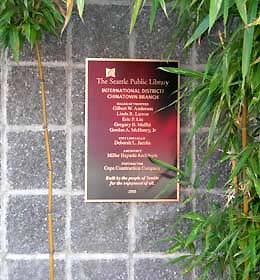Located at 713 8th Avenue S in the International District Village Square II, the International District/Chinatown Branch, The Seattle Public Library, opened on June 11, 2005. Financed by the “Libraries for All” building program, the $735,000 branch is the first Seattle Public Library to be built in the International District/Chinatown neighborhood. The branch specializes in materials in Chinese, Japanese, Korean, Vietnamese and English; staff members are fluent in Cantonese, Mandarin, Korean, Vietnamese, Tagalog, and Lao.
Seattle's Chinatown/International District
The International District/Chinatown neighborhood of Seattle encompasses the blocks east of 5th Avenue S, west of Boren and Rainier avenues S, north of S Dearborn Street, and south of S Main Street. Within the larger neighborhood, three ethnic areas are recognized: The area surrounding King Street is considered Chinatown, the 12th Avenue and Jackson Street area is labeled “Little Saigon,” and Main Street is considered Japantown.
Many Chinese immigrated to the Pacific Northwest between 1860 and 1880 in search of labor in the region’s developing railroad and mining industries. In Seattle, the earliest Chinese immigrants settled near 2nd Avenue and S Washington Street. After the Great Seattle Fire in 1889 demolished much of the original Chinatown and after the Denny Regrade Project altered the city’s topography, what is recognized as Chinatown today took root south along King Street.
While the 1882 Chinese Exclusion Act suspended Chinese immigration to the United State, the late nineteenth century saw a massive influx of Japanese immigration. Many Japanese immigrants settled in NihoMachi, or Japantown, located just north of the King Street Chinatown. But during World War II, all Japanese on the West Coast were forced to evacuate to inland prison camps. At this time many Japanese-owned businesses in Seattle's Japantown were sold or taken over.
In the wake of the Spanish American War, many Filipinos immigrated to the United States; in Seattle they settled in the area around Chinatown and Japantown.
During World War II, African Americans also moved into the neighborhood. Finally, during the late 1970s and early 1980s, in the wake of the Vietnam War, many immigrants from Southeast Asia established what today is known as “Little Saigon” (Crowley, 2004).
The 2000 Census states that the International District is 56 percent Asian, 15 percent black, 15 percent white, and 5 percent Hispanic/Latino. It is recognized as perhaps the only area in the continental United States where Chinese, Japanese, Filipinos, African Americans, Vietnamese, Koreans, and Cambodians settled together and built one neighborhood.
Lacking a Library
Until 2005, the Douglas-Truth Branch located in the Central District was the nearest library for those living in the International District/Chinatown neighborhood. The Beacon Hill Branch was the closest library to provide residents with pertinent foreign-language reading material (Hsu, 2006).
On November 3, 1998, Seattle voters approved the $196.2 million “Libraries for All” bond measure to upgrade The Seattle Public Library with new and renovated facilities, technologies, and books. The International District/Chinatown library became one of the three new neighborhood libraries constructed. The library was built in the International District Village Square II, a five-story complex that includes 57 units of affordable family housing, a community center, retail space, and underground parking.
A Library at Last
In 2002, construction of the International District Village Square II began and the library took part in the building’s grand opening on September 29, 2004. Construction of the actual library began in November 2004.
The new library opened on Saturday, June 11, 2005. Miller Hayashi Architects designed the 3,930-square-foot library with a budget of $735,000. San Francisco-based artist, Rene Yung, collected used teacups from local residents and companies to create sculptural artwork for the branch.
The library seats 40 patrons and has a capacity for 12,000 books and materials with an emphasis on multilingual and multimedia materials, computers, instruction areas, and modern technology services. It specializes in materials in Chinese, Japanese, Korean, Vietnamese and English. Staff members are fluent in Cantonese, Mandarin, Korean, Vietnamese, Tagalog, and Lao.
What's in a Name?
The Chinese community protested the use of “International District” in the name of the library. The community asserted that the title diminishes the historical significance of Chinatown.
This conflict over the library’s name is part of a larger battle to preserve the Chinatown name. “The International District” is recognized as a name more inclusive of all the ethnic communities within the neighborhood (Vinh, 2005).
Branch Managers
- Julie Anne Oyie, June 2005-January 2008
- Misha Stone (interim branch manager), January-June, 2008
- Wei Cai, 2008-present

